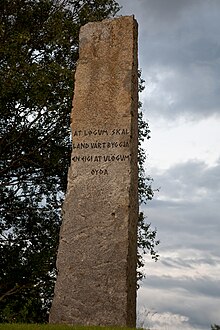
Frostathing law (Frostating's law, Frostating Law, Frostathinglaw, Frostaþing law) (Frostatingsloven) is one of Norway's oldest laws. It concerned the Frostating, which covered large parts of Norway, and derives its name from the ancient court at Frostating. The most famous quote from this law is "at lögum skal land várt byggja en eigi at ulögum øyða" (with law shall our land be built, and not desolated by lawlessness) which also appears in a number of Norse laws, and is inscribed on the illustrated memorial.
It was not the oldest law, which are the Heidsævisthinglaw (or Eidsivathinglaw) and the Gulating law. Later came the Borgathinglaw of Olaf II (1015–1028) but the Frostathing law has been much better preserved, the earlier laws only preserving that which pertained to church law.[1] Together with the Bjarkøy law, these are collectively referred to as the provincial laws.[2] The version that has come down to us dates from around 1260 in the time of Håkon Håkonsson (1217–1263),[1] who inscribed the first chapter with introductory amendments, although portions of the law are likely to be several hundred years older than that. Originally they existed only in oral form at meetings of the Thing. It is first mentioned in the collection of old Norse Sagas by Snorri Sturluson known as the Heimskringla, specifically the Saga of Håkon Håkonsson. Snorri also refers to the later role of Olaf II. In 1280 the Thing more formally adopted the law and Magnus the Good (1035–1047) asked that it be written down. It became known as "Grágás" (Gray Goose), but was quite distinct from the Icelandic Gray Goose Laws (Grágás). This law was progressively modified over time, one of the more important developments in the evolution of Norwegian law being the work of Magnus VI (1263–1280), for which he was nicknamed 'lawmender'.
The Håkon Håkonsson version is also known as the Codex Resenianus, after the historian Peder Hansen Resen who gave the only surviving version to the University of Copenhagen (unfortunately later destroyed in the 1728 fire at the Copenhagen Library). In Norwegian it is found in the Norges gamle Love (I, 121–258) as Den ældre Frostathings-Lov. A modern Nynorsk edition was published in 1994.
The sections dealing with Church law appear to be derived from an older compilation known as the Gullfjǫðr (Goldfeather) by Archbishop Eystein, who sought to bring Norwegian church law in line with the canon law of Gratian.[1]